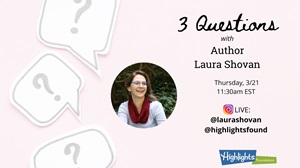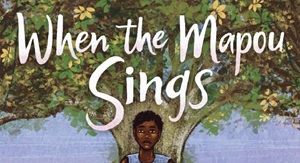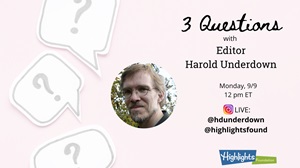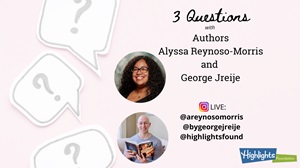Laura Shovan joined Highlights Foundation Social Media Manager Cat Galeano on Instagram Live to talk about the mini-course: Breaks, Blank Space, and Gaps: Poetic Gutters in Novels in Verse and Poetry.
Watch the conversation below. (Please note: closed captions are being added to the video below. When they are finished, you can see them by hovering over the bottom of the video and choosing the “CC” icon.)
Full Transcript:
Cat:
Alright, thank you so much for being with me and a big hello to our Highlights Foundation family. We’re so happy to have you with us. For those that may not know me, I’m Cat Galeano and my pronouns are sh/her, I’m the social media manager for the Highlights Foundation, joining you from Rochester, New York on the traditional lands of the Seewanoy people. Apart from all of the things I get to do at the Highlights Foundation, I’m also a writer and a reader who is very excited to welcome our friend and faculty Laura Shovan. Laura will be teaching the two night mini Breaks, Blank Space, and Gaps: Poetic Gutters in Novels in Verse and Poetry on April 11th and 12th.
But before we dive in, I just want to remind our viewers that joining in on any Highlights Foundation sessions to do so with no hate, no harm and no harassment of any kind. Now let’s get started. What’s, so my first question for you, Laura, is what’s one example–sorry, where did my questions go, there they are–Gutters, breaks and blank space in poetry are really about creating space in the poem to build resonance. Can you share an example of a work you’ve seen recently where this strategy really helped you connect with it?
Laura:
So I’m actually, I’m gonna take this conversation beyond resonance, which is what I’ve been studying and teaching about for about the last year and a half. And what I’ve been looking at is how these spaces in poetry–and then prose as well–but specifically poetry, how do we actively engage readers through, through using these spaces?
And I’m really very much informed by the work of a poet and professor at the University of Baltimore named Steven Leyva, who has this amazing article called Sequential Imagination at the Washington Independent Review of Books. And he talks about as a poet, and a fan of comic books, he started to think about the the comic book term of “gutters,” and the process by which readers move from panel to panel and form, perform a type of closure so that the readers are connecting the two panels that are next to each other in some way, whether it’s a jump in time or even moving from character to character. And Steven was saying, we do the same thing with stanzas and poetry, which really sparked my brain because I had always felt that there was some kind of connection between poetry, especially verse novels, and graphic novels. And this was like I, maybe this is it, maybe this is the thing so. ..
Anyway, I feel like I’ve been talking a lot about how it applies to verse novels in particular. And this, this is like the book, this is the book that talks about the process of closure and how our brains work. And it’s been so informative for me, so I didn’t answer your question. But I’m going to now. I’ve pulled out a poem from this book Rhyme and Rhythm, which is an anthology for student athletes, and I was looking at a short poem by one of the faculty members at Highlights, Padma Venkatraman, called “I Am the Eye” and it’s about an ice skater and this poem is split into two stanzas. So I’m going to read it, and then I’m just going to mention to you where the closure is happening:
So:
“I am the eye, rising up as the music surges. My brown arms are the branches of the swaying tree. I glide, I leap, I fly like a storm tossed leaf, the ice rink shimmers below me. I land. I’m centered. Mountain strong, mountain still, I hold the roots of a whole forest. I bend to no one’s will.”
Padma Venkatraman’s poem “I Am the Eye” is on page 46 of RHYME & RHYTHM: POEMS FOR STUDENT ATHLETES, ed. Sarah J. Donovan.
What’s happening in this poem as far as closure is the first stanza is up in the air. It’s uplift, the the skater is doing tricks and is feeling that sense of flight. And then the second stanza, we move to the ground and so this, that character is feeling very solid on her feet. She’s on the ice. The routine has finished. And what I find so fascinating is not only are we performing the closure, we don’t, we don’t hear the words like “now I’m landing and the routine is ending.” We’re performing that closure as readers, but also if you think about it, on the page, the stanza about flight and movement is above the stanza about being grounded. So we can also use this closure in that way. It’s such a fantastic tool. What I’ve been asking my students to do is use this tool as a way of being intentional. That it’s not just about a break in the page or a break between the poems. To, to have space. It’s really like we are really asking the readers to do something, which is why I get so frustrated–sorry, I’m going on and on…I warned you, this is my favorite subject, but I get frustrated sometimes when people say that verse novels are easier to read and that they’re for, you know, they’re good for kids who are–what’s the word? I don’t like to use some of the the old terminology–But the kids who feel daunted by by a prose novel. And that’s true. But I think it also discounts the fact that we’re asking readers to be very, very actively engaged when we’re writing a verse novel.
Cat:
Thank you for that. Also, I’m so excited you picked that poem, that page in that book, because figure skating personally is one of my favorite sports. So,
Laura:
We were somehow sending each other messages.
Cat:
So when you started talking about that one, I had to close my eyes because I was like, oh, I could already visualize because skating is one of my favorite sports, so I was like, Oh yay! So that’s so great. And two, I, I completely understand what you’re saying, and I appreciate your commentary on that because verse novels in general are active. You have to, there’s less words on the page, you have to pay attention and like the intentionality of where, like you said, the stanzas are placed is so specific, so I love that. You touched on all of that. And I love that, that, that choice of poem that you did and we love Padma. So I love, I love that. Thank you for sharing. So jumping into our second question, when writing, do you build in that space, AS you write, or do you do it in revision or both?
Laura:
So it’s a little bit of both. I’ve been writing poetry for a really long time, and so some of it is intuitive at this point for me, when I’m writing a poem, but I’ve also been thinking about this idea of closure and space as part of my revision process. So when I’m revising especially a verse, a story in verse like an extended narrative in verse, I’m asking myself, am I being intentional about what I’m asking the reader to do between stanzas? Am I even aware of what I’m asking them to do? When they’re moving from one poem to the next, what exactly am I asking? So some of the things I might be asking the reader to do are these. I might be asking them to move forward in time. Or I might be asking them to move back into a memory. That break is enough to say something’s changing, so those are some of the things that might change. It can be a change of setting so it can be moving from place to place. Or especially for, you know, for verse novelists, for poets, it’s often a shift from an external event where the character is reporting on what’s happening to the internal piece. So the interior response some people call that scene and sequel. So the, the reporting piece, a gap, and then how the character feels about it and that, that people use that as a tool in poems often. I mean everybody uses that as a tool. And not everybody, shouldn’t say that. It’s often used as a tool in poetry. But especially in verse novels, when you have a character who’s reporting on action. You know where you have to have an exterior plot balanced with how the character feels about it.
Cat:
Thank you. And unfortunately, we’re at our last question already, which I feel like I would sit here for hours talking verse novel with you. So,sad already we’re coming to our end soon. But our third question is, we know you’re going to talk about this idea, especially as it relates to novels in verse and then talk about how it’s different, and the same, in other genres. Do you also change how you’re using these techniques based on the age group you’re writing for?
Laura:
Not so much the age group. No, I, I think that it really applies to any age group because we’re we’re asking something of the reader. But I do think that even as, as prose writers, this is a tool we can use as well. So when we have breaks between scenes or when we end chapters asking ourselves again what am I asking the reader to perform here? It’s so, it could be a change of scenes, it could be moving a different narrator into place, or a different point of view. You get the idea. So blank space isn’t really blank, it’s the place where the reader can enter and and that they have a job to do.
Cat:
Yeah, because I just think back to like one, one of the examples that always pops into my head is The Long Way Down by Jason Reynolds and like how he just uses that space. And it was funny, because the very first time I read it, I read it as an audio book. So I didn’t catch the spacing of it until somebody was like, what? You should have read the book book first before you did the audio book and I was just like oh. I did it reverse and then I went and I realized I missed an entire part like the–I feel like I missed the essence of the story, like the visual essence at least, because I was like: Oh my God, I did not even realize this is, like how specifically formatted it was, and how, you know, listening to it was like an amazing experience, it was so different because I missed that. So yeah, like, I love that we’re talking about this and how important it is. How it’s important to think about that space when we’re writing or reading.
Laura:
It’s a whole layer. I just, I also pulled out, I’m going to share this one, Carole Boston Weatherford’s Becoming Billie Holiday. Which just, it’s just such a beautiful verse biography and this poem is in three stanzas and I just, would like to, I’m going to read it and I’m going to kind of like, make a hand motion in between the stanzas. But just pay attention to how the breaks are cuing the reader that the setting is changing and the time is changing. It’s called “I Wished On the Moon” so this is, she’s fairly young in this one:
“I may have been poor, may have been orphaned half the time. But for 5 cents, I could lose myself in a bargain matinee sitting front row center at the colored theater, I imagined myself a damsel in satin dripping in diamonds, safe in the hero’s arms. Those movies may have been black and white, but my dream was Technicolor. I left the dark theater squinting in broad daylight, stars in my eyes.”
So we’ve got this, like this scene has a beginning, a middle and an end. They’re marked out by the stanzas. We sort of have this set up. She’s telling us about her background and the fact that she’s walking into the matinee. I could lose myself for 5 cemts. We have the middle part where she’s actually there watching the movie, and then we have the end, which is the moment where she’s walking out, reflecting on it now. She doesn’t have to tell the reader any of those things. She’s using those breaks as a kind of a shorthand to say something’s changing or moving. And this is what we’re going to talk about in the webinar, in the poetry mini. We’re going to spend the first session looking at individual poems, kind of poems that stand alone or that have a a cohesive narrative in and of themselves. And then in the second part of the mini, we’re going to talk about verse novels and short stories in verse. So what I refer to as an extended verse narrative where you’re using multiple poems to create a scene or a story.
Cat:
Oh man, thank you for sharing that. But uh, that was beautiful. I haven’t read that verse novel. I can, I can see my library out my window, so I’m literally going to end this and log out and go pick it up. I’m lucky that I’m two blocks from my library and will definitely have to pick that up. Is there anything else you’d like to add? I feel like you just touched a little bit on the end there…so please, if there’s anything you’d like to add.
Laura:
So what I’d like people to think about is this. If you have a favorite verse novel, start paying attention. To how or where in a story there are multiple poems that work together to create what would be a scene in a prose novel. One of my favorite examples is in The Crossover, Kwame Alexander’s first novel. There’s a series of poems that happen at a basketball game where the two brothers, the twin brothers make a bet, and so it’s a series of about 8 to 10 poems that in a, in a traditional novel would be the inciting incident of the story, but here in a verse novel it’s broken up into these moments into these 8 to 10 poems. So, as preparation for the class, start thinking about what is happening in between those poems. What is the reader being asked to do in those spaces and then we will talk about it in class.
Cat:
Amazing. I will not be monitoring this class, but I will surely be going to our replays to watch it because I am so excited to learn more about this concept of the blank space and everything you mentioned today. So thank you so much Laura, for everything you’ve shared…
And if you would like to learn more from Laura, please make sure to join her next week at mini Breaks, Blank Space, and Gaps: Poetic Gutters in Novels in Verse and Poetry happening on April 11th and 18th. You can register on our website highlightsfoundation.org and lastly you can purchase purchase Laura’s books at our virtual bookshop, oweredbybookshop.org. Thank you, Laura, for joining us today.
Laura:
I see hearts, so hearts back.
Cat:
Heart hearts back for everyone else. Thank you so much for joining us. Thank you, Laura.
Laura:
Bye, Cat. Take care.







